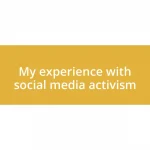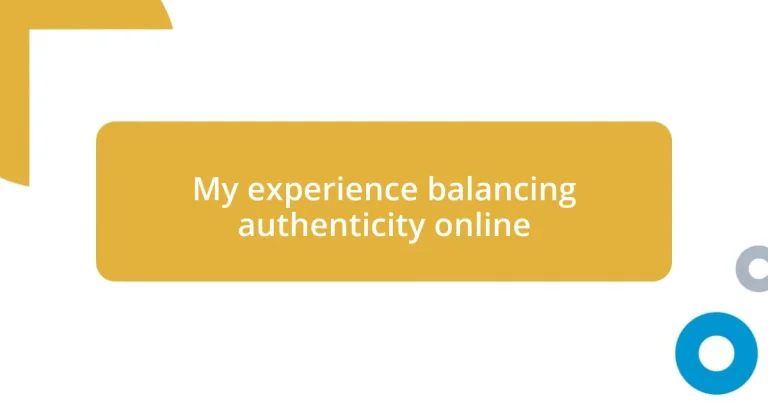Key takeaways:
- Authenticity online involves sharing both victories and vulnerabilities, fostering genuine connections.
- Identifying personal values, such as honesty and empowerment, helps in creating relatable and impactful content.
- Engaging with the audience through active listening and shared experiences can deepen relationships and build community.
- Feedback is crucial for growth, encouraging reflection and adaptation in content creation for better relatability.

Understanding online authenticity
Authenticity online isn’t just a buzzword; it’s a fundamental aspect of how we connect with others in a digital space. I remember feeling torn about sharing my true self on social media, often posting highlights while sidelining my struggles. It made me wonder: is there truly authenticity in a highlight reel?
When I began to share both my victories and vulnerabilities, I noticed a profound shift. The moment I posted about my anxiety, my friends reached out with their own stories, creating a genuine sense of community. It’s incredible how real connections form when we let go of the façade—what’s stopping you from showing your authentic self?
However, I’ve learned that balancing authenticity and privacy can be tricky. For instance, I once shared a personal story that left me feeling exposed, questioning whether I had overshared. It’s a delicate dance between being open and protecting your own emotional landscape; how do you navigate this balance in your online presence?

The impact of social media
As I reflect on my engagement with social media, I can’t help but notice the paradox it presents. On one hand, it allows us to connect with a wider audience, but it can also foster feelings of inadequacy when we compare our reality to others’ curated images. I recall scrolling through a friend’s post celebrating an extravagant vacation while I was just trying to make it through a tough week. That moment highlighted how social media can distort our perceptions, making it challenging to remain grounded in our authenticity.
- Social media acts as a double-edged sword, facilitating connections while also heightening comparisons.
- It has the power to amplify anxiety, leading users to feel less than enough when faced with filtered realities.
- Balancing the urge to share and the need for authenticity can create inner conflict.
Despite these challenges, there’s a beauty in vulnerability. When I started sharing my less-than-perfect moments, I was amazed at the outpouring of support and understanding from others. It was a reminder that behind every perfect post, there are stories of struggle. This journey taught me that genuine engagements often come from sharing the messy parts of life, reinforcing that I am not alone in my experiences.

Identifying personal values
Identifying personal values is a crucial step in presenting an authentic version of ourselves online. I remember taking time to reflect on what truly mattered to me—things like honesty, kindness, and empowerment. By aligning my online presence with these core values, I found it easier to create content that felt genuine and resonated with others.
As I navigated through various social platforms, I noticed that sharing posts that reflected my values drew in a community of like-minded individuals. For example, I once shared my perspective on mental health awareness, which sparked meaningful conversations about self-care. It felt fulfilling to engage with people who shared similar outlooks, reinforcing the importance of value-driven connections.
It’s interesting to observe how personal values shape our online interactions. When I recall a time I posted about the importance of vulnerability in friendships, the responses were overwhelmingly positive. Seeing others share their stories made me realize that authenticity attracts authenticity. By staying true to my values, I am cultivating a space where openness thrives, allowing for genuine relationships to flourish.
| Value | Impact on Online Presence |
|---|---|
| Honesty | Encourages candid sharing and builds trust. |
| Kindness | Creates a positive environment that invites engagement. |
| Empowerment | Inspires others to share their own journeys and support one another. |

Creating authentic content
Creating authentic content starts with a deep understanding of oneself. I vividly recall a time when I hesitated to share a personal struggle in my writing. I wondered, “Will people think less of me?” But, when I finally mustered the courage to share my feelings about burnout, the response was overwhelming. People related to that experience, and it built a bridge of honesty that allowed others to come forward with their own stories.
In another instance, I tried experimenting with different content styles, aiming for what “looks good” on the surface. It felt like I was playing a role—a flat character in a play rather than being myself. I quickly realized that while those aesthetic posts garnered fleeting likes, they didn’t spark meaningful interactions. When I shifted my focus to sharing everyday moments, like my attempts at baking gone wrong or candid snapshots from my work-from-home life, I saw a significant uptick in genuine engagement. It’s a reminder that the messiness of life often resonates more than polished perfection.
Authenticity isn’t just a buzzword; it’s a commitment to being open and transparent. I’ve found that including personal anecdotes makes my content relatable and impactful. For instance, discussing my experiences with anxiety allowed me to connect on a deeper level with my audience. It raises a question—how many of us are willing to strip away the perfection and reveal our true selves? By doing so, I’m not just building an online presence; I’m cultivating a community where others feel safe to share their realities too.

Engaging with your audience
Engaging with your audience often starts with active listening. I remember when a follower shared a heartfelt comment on one of my posts about overcoming obstacles. Instead of a simple “thank you,” I took the time to respond thoughtfully, relating my own experiences and encouraging them to continue sharing. That small interaction turned into an ongoing dialogue, illustrating how genuine engagement fosters deeper connections.
It’s fascinating how asking questions can invite more participation. I once posed a query about what self-care looks like for different people, and the responses poured in! I was amazed at how sharing varied perspectives sparked an enriching conversation. Through this, I found that not only did others feel valued—but it also reinforced my belief that a community thrives on shared insights and experiences.
Reflecting on my journey in engaging with my audience, I’ve realized that vulnerability can be a powerful tool. When I openly discussed my fear of public speaking, I was met with countless messages of encouragement and shared anxieties from others. It hit me how these moments of honesty can dismantle barriers, creating a safe space for everyone to express their thoughts and feelings. This shared vulnerability makes the online experience feel less isolating, don’t you think?

Managing online vs offline identity
Managing the balance between my online and offline identity has been an evolving journey for me. I remember a time when I’d post about my professional achievements without sharing my personal struggles. It felt like I was wearing a mask, projecting a polished image that didn’t reflect the realities of my life. I often wondered, “Is this who I really am, or just a highlight reel?” Eventually, I realized that embracing both sides fosters authenticity and creates more genuine relationships with those who follow my journey.
Navigating these identities can sometimes feel like walking a tightrope. One day, I shared a post about feeling overwhelmed by life’s chaos, alongside a picture of my cluttered desk. That moment sparked a flurry of comments from friends who admitted they felt the same way, leading me to ask, “Why do we feel the need to hide our true selves?” It became clear to me that by being vulnerable online, I encouraged others to drop their facades too. In doing so, I transformed my platforms from mere showcases of success into spaces for shared human experiences.
On the flip side, I’ve also encountered moments where my offline self has clashed with the online persona I projected. I vividly recall attending a conference where I felt the pressure to be the confident speaker everyone saw on social media. In contrast, I felt nervous and unsure. I had to remind myself that it’s okay to not have everything figured out in real life, and that authenticity lies in showing up as I am. This realization led me to ask, “Am I solely defined by my online presence, or is there more to my story?” Balancing these identities remains a challenge, but it also fuels deeper connections and growth.

Learning from feedback and growth
Feedback can be a powerful catalyst for growth, and I’ve learned to embrace it wholeheartedly. I recall a moment when I received constructive criticism about a piece I had written. At first, I felt defensive, but then I took a step back and realized the person was actually trying to help me improve. This experience taught me that viewing feedback as an opportunity rather than a setback allows me to refine my voice even further.
As I engaged more deeply with my audience, feedback often led to unexpected insights. There was a time when someone pointed out that my use of technical jargon was alienating, and their honest input opened my eyes. I began to assess how I present information, ensuring it’s not just relatable but also accessible to everyone. This instance reminded me that learning from my audience is a two-way street; it’s not just about me sharing my story, but about understanding what resonates with others.
I often find myself reflecting on whether I’m actively seeking this growth. It’s easy to get comfortable in our routines, isn’t it? Every now and then, I ask my followers for feedback on my content, and their responses guide my journey. That connection reinforces my commitment to authenticity and encourages me to continue evolving. How can we grow if we don’t engage with those who are on this journey with us? I believe that these shared experiences with our audience not only enhance our authenticity but also enrich our personal narratives.














